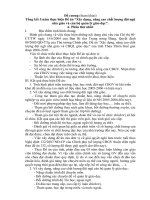Lecture Web technologies and programming – Lecture 5: Web application architecture - TRƯỜNG CÁN BỘ QUẢN LÝ GIÁO DỤC THÀNH PHỐ HỒ CHÍ MINH
Bạn đang xem bản rút gọn của tài liệu. Xem và tải ngay bản đầy đủ của tài liệu tại đây (341.17 KB, 10 trang )
<span class='text_page_counter'>(1)</span><div class='page_container' data-page=1></div>
<span class='text_page_counter'>(2)</span><div class='page_container' data-page=2>
2
</div>
<span class='text_page_counter'>(3)</span><div class='page_container' data-page=3></div>
<span class='text_page_counter'>(4)</span><div class='page_container' data-page=4>
• <b>System modeling</b>
• <b>Requirement Modeling</b>
– <b>use-case diagram, activity diagram</b>
• <b>Content modeling</b>
– <b>class diagram, state machine diagram</b>
• <b>Navigation modeling</b>
• <b>Presentation modeling</b>
</div>
<span class='text_page_counter'>(5)</span><div class='page_container' data-page=5>
•
<b>Technologies for web development</b>
•
<b>Protocol</b>
– <b>client-side technologies</b>
– <b>server-side technologies</b>
•
<b>Testing web applications</b>
</div>
<span class='text_page_counter'>(6)</span><div class='page_container' data-page=6>
•
<b>Software system architecture</b>
•
<b>Specifics of web application </b>
<b>architecture</b>
•
<b>Layered web architecture</b>
– <b>2-layered architecture</b>
– <b>3-layered architecture</b>
– <b>N-layered architecture</b>
</div>
<span class='text_page_counter'>(7)</span><div class='page_container' data-page=7>
•
<b>The </b>
<b>architecture</b>
<b> of a computer system </b>
<b>is the high-level (most general) design </b>
<b>on which the system is based</b>
•
<b>Architectural features include</b>
<b>:</b>
– <b>Components (</b>a <b>Component</b> is a part of
a <b>program)</b>
• It contains one or several routines
</div>
<span class='text_page_counter'>(8)</span><div class='page_container' data-page=8>
8
•
<b>Key</b>
<b> attributes </b>
<b>of an architecture</b>
– <b>architecture describes structure</b>
– <b>architecture forms the transition from </b>
<b>analysis to implementation</b>
– <b>different viewpoints (conceptual, runtime, </b>
<b>process and implementation)</b>
</div>
<span class='text_page_counter'>(9)</span><div class='page_container' data-page=9>
•
<b>Factors</b>
<b> influence</b>
<b> the system </b>
<b>architecture</b>
Architecture
<b>Quality considerations with</b>
• <b>Performance</b>
• <b>Scalability</b>
• <b>Reusability</b>
• <b>Other?</b>
<b>Functional Requirements</b>
• <b>Clients</b>
• <b>Users</b>
</div>
<span class='text_page_counter'>(10)</span><div class='page_container' data-page=10>
10
•
<b>Factors</b>
<b> influence</b>
<b> the system </b>
<b>architecture</b>
Architecture
<b>Experience with</b>
• <b>Existing Architecture</b>
• <b>Patterns</b>
• <b>Project Management</b>
• <b>Other?</b>
<b>Technical Aspects</b>
• <b>Operating System</b>
• <b>Middleware</b>
• <b>Legacy Systems</b>
</div>
<!--links-->









